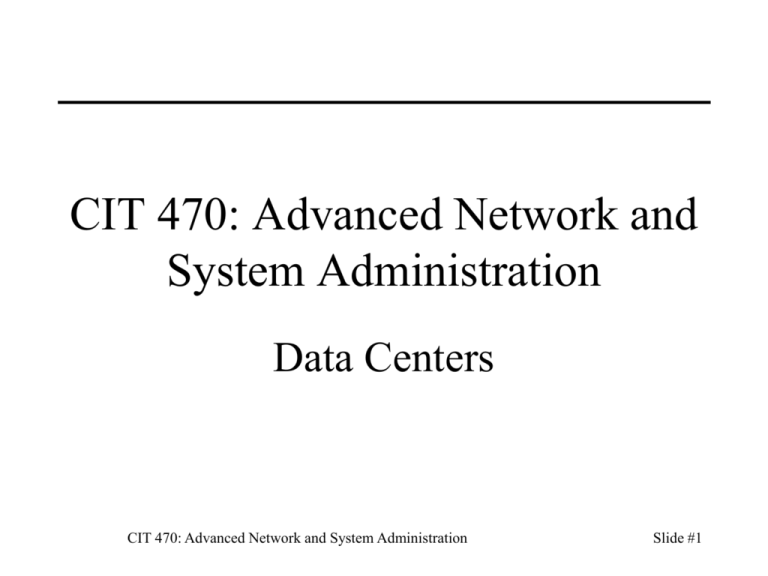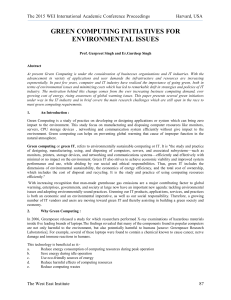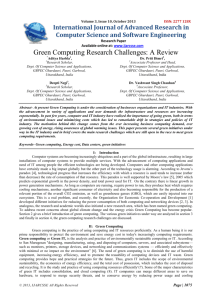Introduction
advertisement

CIT 470: Advanced Network and System Administration Data Centers CIT 470: Advanced Network and System Administration Slide #1 Topics Data Center: A facility for housing a large amount of computer or communications equipment. 1. 2. 3. 4. 5. 6. Racks Power PUE Cooling Containers Economics Google DC in The Dalles Located near 3.1GW hydroelectric power station on Columbia River Google DC in The Dalles Inside a Data Center Inside a Container Data Center Data Center is composed of: • A physically safe and secure space • Racks that hold computer, network, and storage devices • Electric power sufficient to operate the installed devices • Cooling to keep the devices within their operating temperature ranges • Network connectivity throughout the data center and to places beyond Data Center Components Data Center Tiers See http://uptimeinstitute.org/ for more details about tiers. Racks: The Skeleton of the DC • 19” rack standard – EIA-310D – Other standard numbers. • NEBS 21” racks – Telecom equipment. • • • • 2-post or 4-post Air circulation (fans) Cable management Doors or open Rack Units Rack Sizes http://www.gtweb.net/rackframe.html Rack Purposes Organize equipment – Increase density with vertical stacking. Cooling – Internal airflow in rack cools servers. – Data center airflow determined by arrangement of racks. Wiring Organization – Cable guides keep cables within racks. Rack Power Infrastructure • Different power sockets can be on different circuits. • Individual outlet control (power cycle.) • Current monitoring and alarms. • Network managed (web or SNMP.) Rack-Mount Servers 1U 4U Blade Servers Buying a Rack Buy the right size – Space for servers. – power, patch panels, etc. Be sure it fits your servers. – Appropriate mounting rails. – Shelves for non-rack servers. Environment options – – – – Locking front and back doors Sufficient power and cooling. Power/environment monitors. Console if needed. Space Aisles Wide enough to move equipment. Separate hot and cold aisles. Hot spots Result from poor air flow. Servers can overheat when average room temperature is too low. Work space A place for SAs to work on servers. Desk space, tools, etc. Capacity Room to grow. Data Center Power Distribution http://www.42u.com/power/data-center- UPS (Uninterruptible Power Supply) Provides emergency power when utility fails – Most use batteries to store power Conditions power, removing voltage spikes Standby UPS • • • • • Power will be briefly interrupted during switch Computers may lockup/reboot during interruption No power conditioning Short battery life Very inexpensive http://myuninterruptiblepowersupply.com/toplogy.htm Online UPS • • • • • AC -> DC -> AC conversion design True uninterrupted power without switching Extremely good power conditioning Longer battery life Higher price http://myuninterruptiblepowersupply.com/toplogy.htm Power Distribution Unit (PDU) Takes high voltage feed and divides into many 110/120 V circuits that feed servers. – Similar to breaker panel in a house. Estimating Per-Rack Power The Power Problem • 4-year power cost = server purchase price. • Upgrades may have to wait for electricity. • Power is a major data center cost – $5.8 billion for server power in 2005. – $3.5 billion for server cooling in 2005. – $20.5 billion for purchasing hardware in 2005. Measuring Power Efficiency PUE is ratio of total building power to IT power; efficiency of datacenter building infrastructure SPUE is ratio of total server input to its useful power, where useful power is power consumed by CPU, DRAM, disk, motherboard, etc. Excludes losses due to power supplies, fans, etc. Computation efficiency depends on software and workload and measures useful work done per watt Power Usage Effectiveness (PUE) PUE = Data center power / Computer power – PUE=2 indicates that for each watt of power used to power IT equipment, one watt used for HVAC, power distribution, etc. – Decreases towards 1 as DC is more efficient. PUE variation – Industry average > 2 – Microsoft = 1.22 – Google = 1.19 Data Center Energy Usage Sources of Efficiency Losses UPS – 88-94% efficiency – Less if lightly loaded PDU voltage transformation – .5% or less Cables from PDU to racks – 1-3% depending on distance and cable type Computer Room Air Conditioning (CRAC) – Delivery of cool air over long distances uses fan power and increases air temperature Cooling a Data Center • Keep temperatures within 18-27 ◦C • Cooling equipment rated in BTUs – 1 Watt = 3412 BTUH – BTUH = British Thermal Unit / Hour • Keep humidity between 30-55% – High = condensation – Low = static shock • Avoid hot/cold spots – Can produce condensation Computer Room Air Conditioning • Large scale, highly reliable air conditioning units from companies like Liebert. • Cooling capacity measured in tons. Waterworks for Data Center Estimating Heat Load Hot-Cold Aisle Architecture • Server air intake from cold aisles • Server air exhaust into hot aisles • Improve efficiency by reducing mixture of hot/cold Free Cooling • Cooling towers dissipate heat by evaporating water, reducing or eliminating need to run chillers • Google Belgium DC uses 100% free cooling Improving Cooling Efficiency Air flow handling: Hot air exhausted by servers does not mix with cold air, and path to cooling coil is very short so little energy spent moving Elevated cold aisle temperatures: Cold aisle of containers kept at 27◦C rather than 18-20◦C. Use of free cooling: In moderate climates, cooling towers can eliminate majority of chiller runtime. Server PUE (SPUE) Primary sources of inefficiency – Power Supply Unit (PSU) (70-75% efficiency) – Voltage Regulator Modules (VRMs) • Can lose more than 30% power in conversion losses – Cooling fans • Software can reduce fan RPM when not needed SPUE ratios of 1.6-1.8 are common today Power Supply Unit Efficiency 80 PLUS initiative to promote PSU efficiency – 80+% efficiency at 20%, 50%, 100% of rated load – Can be less than 80% efficient at idle power load First 80 PLUS PSU shipped in 2005 Server Useful Power Consumption Device Power Usage Intel Xeon W5590 3.33 GHz Quad Core 130 W Intel Xeon E5430 2.66 GHz Quad Core 80W Intel Xeon E5502 2.13 GHz Dual Core 80W 7200RPM Hard Drive 7W 10,000RPM Hard Drive 14W 15,000RPM Hard Drive 20W DDR2 DIMM 1.65W Video Card 20-120W The best method to determine power usage is to measure it https://www.wattsupmeters.com/ Server Utilization ~10-50% “The Case for Energy-Proportional Computing,” Luiz André Barroso, Urs Hölzle, IEEE Computer, December 2007 It is surprisingly hard to achieve high levels of utilization of typical servers (and your home PC is even worse) Figure 1. Average CPU utilization of more than 5,000 servers during a six-month period. Servers are rarely completely idle and seldom operate near their maximum utilization, instead operating most of the time at between 10 and 50 percent of their maximum Server Power Usage Range: 50-100% “The Case for Energy-Proportional Computing,” Luiz André Barroso, Urs Hölzle, IEEE Computer, December 2007 Energy efficiency = Utilization/Power Figure 2. Server power usage and energy efficiency at varying utilization levels, from idle to peak performance. Even an energy-efficient server still consumes about half its full power when doing virtually no work. Latency Server Utilization vs. Latency Utilization 100% Improving Power Efficiency Improving Power Efficiency Application consolidation – Reduce the number of applications by eliminating old applications in favor of new ones that can server the purpose of multiple old ones. – Allows elimination of old app servers. Server consolidation – Use single DB for multiple applications. – Move light services like NTP onto shared boxes. Use SAN storage – Local disks typically highly underused – Use SAN so servers share single storage pool Improving Power Efficiency Virtualization – Host services on VMs instead of on physical servers – Host multiple virtual servers on single physical svr Only-as-needed Servers – Power down servers when not in use – Works best with cloud computing Granular capacity planning – Measure computing needs carefully – Buy minimal CPU, RAM, disk configuration based on your capacity measurements and forecasts Containers Data Center in a shipping container. – 4-10X normal data center density. – 1000s of servers. – 100s of kW of power. Advantages – – – – Efficient cooling High server density Rapid deployment Scalability Vendor offerings: http://www.datacentermap.com/blog/datacenter-container-55.html Microsoft Chicago Data Center Google Container Patents Containers docked at central power spline Vertical stack of containers Container air flow diagram, with a center cold aisle and hot air return behind servers Data Center Failure Events Hardware Isn’t Reliable Enough If servers are 99% reliable, then a system with 10 servers is 0.9910 ≈ 90% reliable a system with 100 servers is 0.99100 ≈ 37% reliable 0.99^n 1 0.8 0.6 0.4 0.2 0 1 11 21 31 41 51 61 71 81 91 Fault-Tolerant Architecture Must use fault-tolerant software architecture – Hardware must detect faults – Hardware must notify software in timely fashion Fault-tolerant architecture reduces costs – Choose hardware reliability level that maximizes cost efficiency, not just reliability Fault-tolerant architecture can improve perf – Spreading processing and storage across many servers improves bandwidth and CPU capacity Causes of Service Disruptions Total Cost of Ownership (TCO) TCO = Data Center Depreciation + Data Center Operating Expenses (Opex) + Server Depreciation + Server Operating Expenses (Opex) Depreciation is the process of allocating cost of assets across period during which assets are used. Example: server cost = $10,000, $0 residual value annual depreciation over 4 years = $2500 Cost to Build Data Center • Primary components (power, cooling, space) scale roughly linearly with space. • 80% of total construction cost goes to power + cooling • Typical depreciation periods of 10-15 years Operational Costs Operational costs include – – – – Electricity Salaries for personnel Server maintenance contracts Software licenses Larger data centers are cheaper – Smaller number of sysadmins per server – Fixed number of security guards For multi-MW data center, $0.02-$0.08/month Case Study Tier 3 multi-MW data center – – – – – – – – – Dell 2950 III EnergySmart servers (300W, $6000) Cost of electricity is 6.2₵/kW Servers financed with 3-year loan @ 12% Cost of DC construction is $15/W, 12-yr lifetime DC opex is 4₵/month PUE = 2.0 Server lifetime is 3 years Server maintenance is 5% of capex Server avg power = 75% peak Key Points Data center components – – – – – Physically secure space Racks, the DC skeleton Power, including UPS and PDU Cooling Networking Power efficiency (server cost = 4 years power on avg) – PUE = Data center power / IT equipment power – Most power in traditional DC goes to cooling, UPS – SPUE = Server PUE; inefficiencies from PSU, VRM, fans Cooling – – – – Heat load estimation Air flow control (hot/cold aisle architecture or containers) Higher cold air temperatures (27C vs. 20C) Free cooling (cooling towers) TCO = DC depr + DC opex + Svr depr + Svr opex References 1. 2. 3. 4. 5. Luiz Andre Barroso and Urs Holzle, The Case for EnergyProportional Computing, IEEE Computer, Vol 40, Issue 12, December 2007. Luiz Andre Barroso and Urs Holzle, The Datacenter as a Computer: An Introduction to the Design of Warehouse-Scale Machines, 1st edition, Morgan and Claypool Publishers Xiaobo Fan, Wolf-Dietrich Weber, Luiz Andre Barroso, Power provisioning for a warehouse-sized computer, ISCA '07: Proceedings of the 34th annual international symposium on Computer architecture Thomas A. Limoncelli, Christina J. Hogan, and Strata R. Chalup, The Practice of System and Network Administration, Second Edition, Addison-Wesley Professional, 2007. Evi Nemeth, Garth Snyder, Trent R. Hein, Ben Whaley, UNIX and Linux System Administration Handbook, 4th edition, Prentice Hall, 2010.




